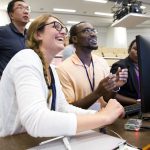Highlights from Emory’s Exposome Summer Course
The Emory Exposome Summer Course brought together 150 people from seven countries and more than two-dozen institutions to focus on the current state and future directions of exposome research. For five days, attendees heard from leaders in the exposome field, participated in hands-on lab sessions to learn about new tools for exposome research, and developed and discussed ideas with fellow attendees and course speakers.
The Interdisciplinary Nature of Exposome Research
Although many of the leaders in exposome research are toxicologists and exposure scientists, the diversity of disciplines represented by course attendees demonstrated the significant interest from other fields along with a recognized need to include and understand the impact of complex environmental exposures. The perspectives offered by this diverse group throughout the week provided a window into the crosstalk required to bring a human exposome project to fruition. Nursing, sociology, nutrition, bioinformatics, neuroscience, and human genetics were just a few of the disciplines represented.
A few highlights from the poster session demonstrate the interdisciplinary nature of the course:
- Bridget Hanna from Harvard University presented “The socio-exposome: advancing exposure science and environmental justice in a post-genomic era”
- Sandra Andrusaityte from Vytautas Magnus University in Lithuania presented “Longitudinal influences of neighborhood green spaces on children’s asthma and overweight”
- Ibon Tamayo Uria from HELIX (CREAL/ISGlobal) presented “The outdoor exposome during pregnancy and its social determinants”
Tools for the Exposome
The challenges of capturing the complexity of exposures and their potential health effects across the lifetime are vast. Yet the significance of these challenges also speaks to the great need for moving the exposome forward. The tools covered in the afternoon lab sessions throughout the course introduced participants to what is currently available to tackle the exposome and also provided a window into what new development opportunities could advance research.
The Human Toxome Project, the Comparative Toxicogenomics Database and other tools such as ToxCast and ExpoCast developed by the U.S. EPA take advantage of completed research through cataloguing results and mining the data, allowing new connections to be drawn and new research questions to be more effectively targeted. With the thousands of chemicals with little or no toxicity information (and more in development), strategies that inform the prioritization of specific chemical testing allows finite research resources to be focused on areas with the greatest chance of positively impacting human health. Continued integration and synchronization of available databases has the potential to quickly advance environmental health research forward.
“Omics” data is a key part of exposome research, providing insight into what chemical exposures are occurring and the body’s biological response. One day of the course was dedicated to metabolomics for the exposome with a focus on the high resolution metabolomics (HRM) workflow at Emory. HRM has particular utility for the exposome in that it can detect thousands of chemical signatures in a single sample run with continued opportunity for advancements due to improved instrumentation, techniques, and data extraction algorithms. The day following the metabolomics session was focused on the integration of omics data utilizing tools such as STITCH to assess chemical and protein interactions.
As demonstrated throughout the week, the research community’s ability to produce data through omics and various high-throughput techniques (e.g. C. elegans Lifespan Machine for systems biology applications) only continues to grow. This level of data shows great promise for exposome research but only if it can be effectively shared and used. Chirag Patel and Nam Pho’s session on Environment-wide Association Studies clearly highlighted how data sharing and open-source analytical tools can help create a research environment that fosters the complex analyses required to answer exposome-level questions.
The poster session provided examples of new tools for exposome research beyond those covered by the lab sessions:
- Fernando Martin Sanchez from Weill Cornell Medicine presented “The G*E*P Game: an educational tool for understanding the Genome-Exposome interplay”
- Carles Hernandez-Ferrer from HELIX (CREAL/ISGlobal) presented “rexposome: A bioinformatic tool for characterizing multiple environmental factors and its association with different omics biomarkers and disease”
- Karan Uppal from Emory University presented “xMSannotator: an R package for network-based annotation of high-resolution metabolomics data”
 As the data available for the exposome research grows, cloud solutions for analyzing and housing data will become increasingly important. Amazon Web Services provided an introduction to what tools they offer to researchers. Multiple lab sessions utilized cloud services to run analyses, stream personal sensor data (Raspberry Pis) into a given analysis, and house pre-developed data analysis packages (Environment-wide Association Studies). As participants learned throughout the week, cloud computing has great potential that for the most part has yet to be realized.
As the data available for the exposome research grows, cloud solutions for analyzing and housing data will become increasingly important. Amazon Web Services provided an introduction to what tools they offer to researchers. Multiple lab sessions utilized cloud services to run analyses, stream personal sensor data (Raspberry Pis) into a given analysis, and house pre-developed data analysis packages (Environment-wide Association Studies). As participants learned throughout the week, cloud computing has great potential that for the most part has yet to be realized.
What’s Next for the Exposome
Although much progress has been made, much lies ahead for exposome research. Meetings such as this will be key to facilitate the collaborations and team science initiatives required to understand the exposome and its impact on human health.
Exposome colleagues hinted at future exposome courses and research symposiums. High-level planning, strategizing and promotion will be key to increase support from the scientific community and funding agencies. As we move forward from this event, we hope the ideas, experiences, discussions, and new connections will continue to foster advancement for the field of the exposome.
Curious about the course agenda – click here
See Dr. Christopher Austin’s closing session here
Photo album with highlights of the course activities and a few closing thoughts from course speakers
See perspectives from the course participants on twitter – search for #emoryexposome




